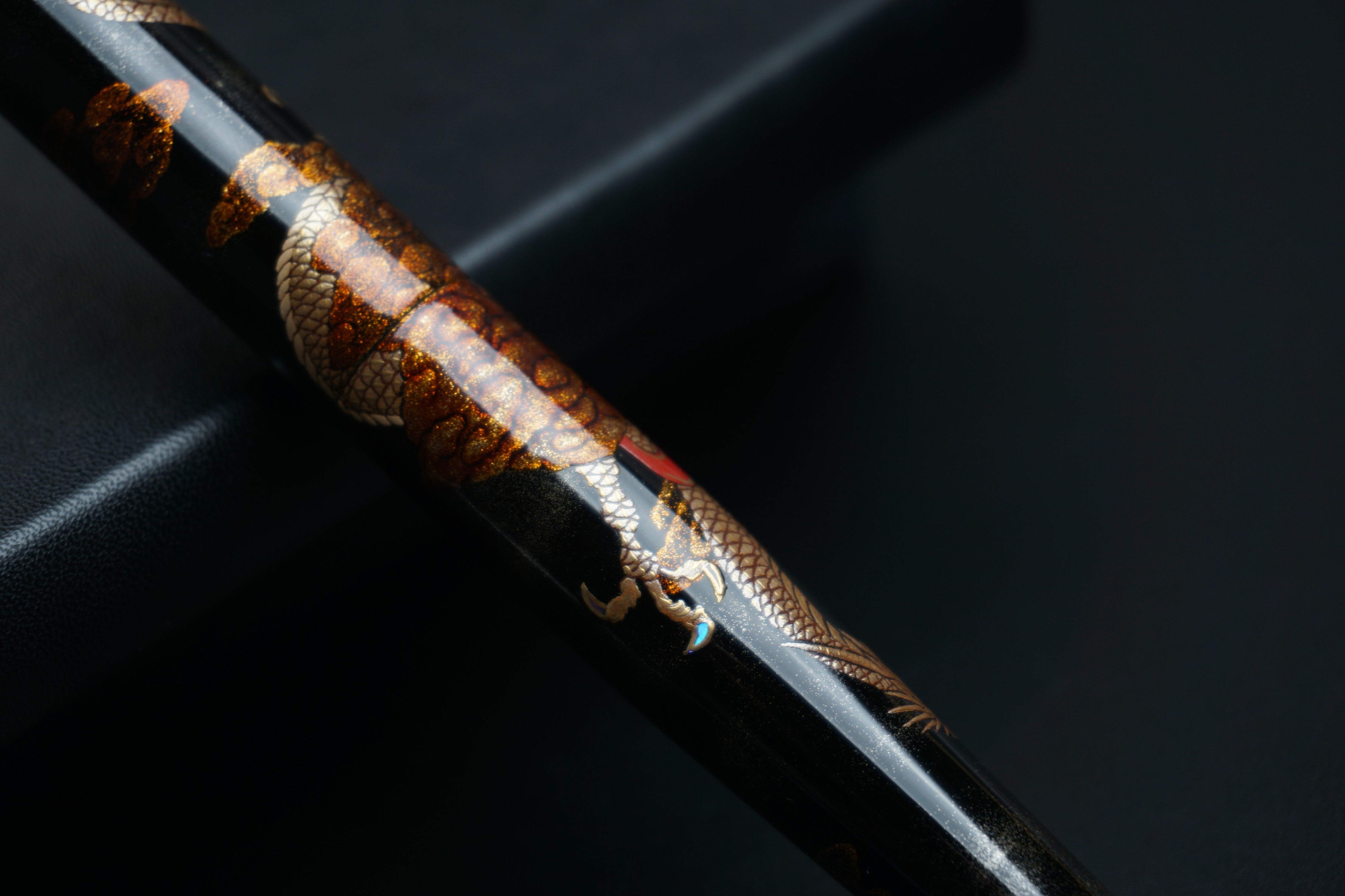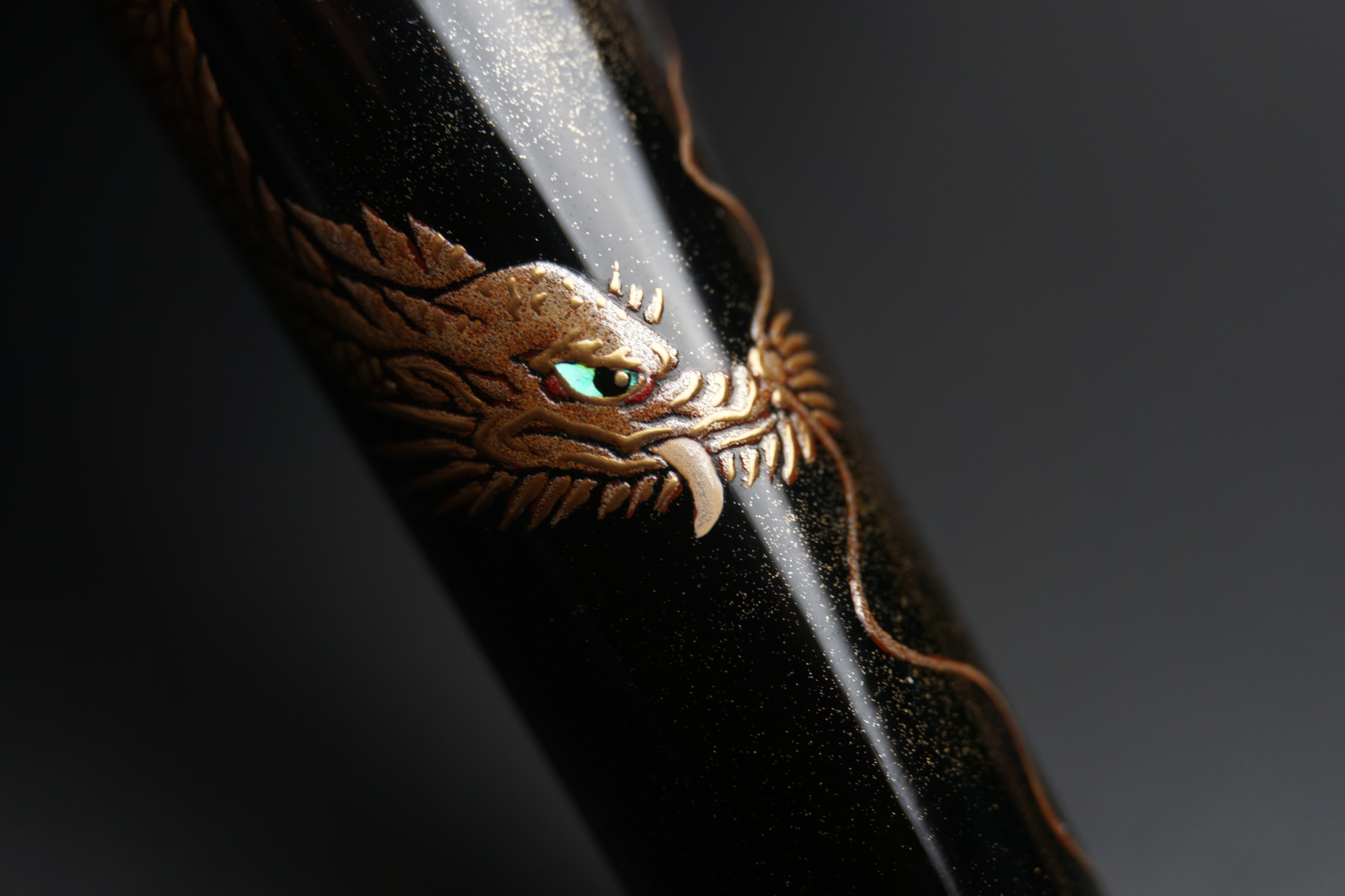ShiZen Dragon's Descent Taka-maki-e on Ranga M4C Fountain Pen
Starting at $690/mo for 6 month no-interest installments, 10% down using 
Learn about our Payment Relief Plan. |
|---|
Couldn't load pickup availability
✓ 100% Genuine Urushi
✓ Contains the Maki-E Red Seal (Highest Quality of Maki-E Art)
✓ Hand-painted by highly-trained Japanese Artisans
Dragons are one of the most influential creatures in Japanese folklore illustrated in various objects and formats. Keisuke-san demonstrates extreme precision and masterful skill by pushing maki-e techniques to the brim in this masterpiece. His depiction of the dragon is one of the most detailed of dragon art on maki-e pens. One of his inspirations for achieving such vivid detail in the dragon is his love of anime (Japanese Cartoon) where dragons are commonly intricately illustrated. The most difficult feat was in the individual scales -- they are meticulously placed at an even spacing with line patterns within each scale in itself; the perfection of the consistency applied across the entire motif all by hand with no magnification is almost unfathomable. The focal point of this artwork is in the eyes of the dragon; it was crafted to highlight its character: sharp, fierce, but at the same time gentle as perceived by the Japanese to be guardians of heaven and earth. Clouds cover portions of the dragon body to depict the descent of the dragon as if from the heaven's. Clouds are made with an assortment of techniques to produce the 3-dimensional look: hira-maki-e (flat design), taka-maki-e (raised design), as well as an embedded design technique. Dragon is drawn with taka-maki-e with raden abalone applied on the eyes and the claws. Sprinkles of golden maki-e powder is scattered across the pen.
About Ranga M4C Pen Body and Filling System:
This pen was produced in partnership with Ranga Pens. Urushi lacquer is applied over a solidly constructed handmade Ranga model 4C ebonite pen body, including the threads.
Pen comes with an international pen converter but pen barrel chamber can also be filled eye dropper style (eye dropper does not come with pen).
Nib Details:

This pen is furnished with a ShiZen 18k Gold, two-toned #6 nib, medium tip (currently ShiZen only offers one size: Medium)
The logo depicts an enso circle around a bonsai tree. Both of these illustrations have connections to Zen Buddhism. Enso circle represents a tranquil meditative state where one's mind is able to be emptied so that they can exercise immense creativity. Bonsai trees are commonly grown in Japan as they are perceived as living things that require discipline to care for them -- they also serve as harmony between nature and human-beings.
Technical Specification:
| Cap Length | 71 mm (2.8") |
| Cap Diameter | 16 mm (0.63") |
| Section Diameter | 11 mm (0.43") |
| Barrel Length | 114 mm (4.5") |
| Barrel Diameter | 16 mm (0.63") |
| Pen Length (Closed) | 152.4 mm (6") |
| Pen Length (Posted) | Do not post cap |
| Weight | 29 g (1.02 oz) |
| Weight (w/ink) | 30 g (1.06 oz) |
| Filling System | Cartridge/Converter/Eyedropper |
About the Artisan:

Maki-e artisan Keisuke Seki lacquered this pen. Born in 1978, he was raised in Tsu City, Mie Prefecture and grew up with a love of drawing. As a child, his mother had told him that he would make a good maki-e artisan. His mother's words inspired him into becoming a maki-e artisan later in life. After graduating high school, he entered Kyoto Traditional Crafts College in Kyoto and studied lacquer and maki-e for 2 years. He later applied and was accepted to be an apprentice under Yutaro Shimode, a graduate school professor and one of Japan's leading maki-e artisans who was known for restoring maki-e at a very prestigious shrine Ise Jingu and made lacquered products for the emperor and his wife as well as state guests. After training with Yutaro for 8 years, he became independent and took over his family business. He has lacquered various objects such as Buddhist altars, temple boxes, incense containers, sword sheaths, and tea ceremony items. He has also added to his arsenal other objects such as glasses, accessories, jewelry, and pearls. He is inspired by nature, inorganic objects, imaginary creatures, and hints of human interaction. He has won numerous awards in technical competitions sponsored by Kyoto Batsugu Cooperative Association. He has also obtained certification as a certified craftsman of kyomono and has been successful at launching a traditional craft accessories brand which has received high acclaim in various circles.






















